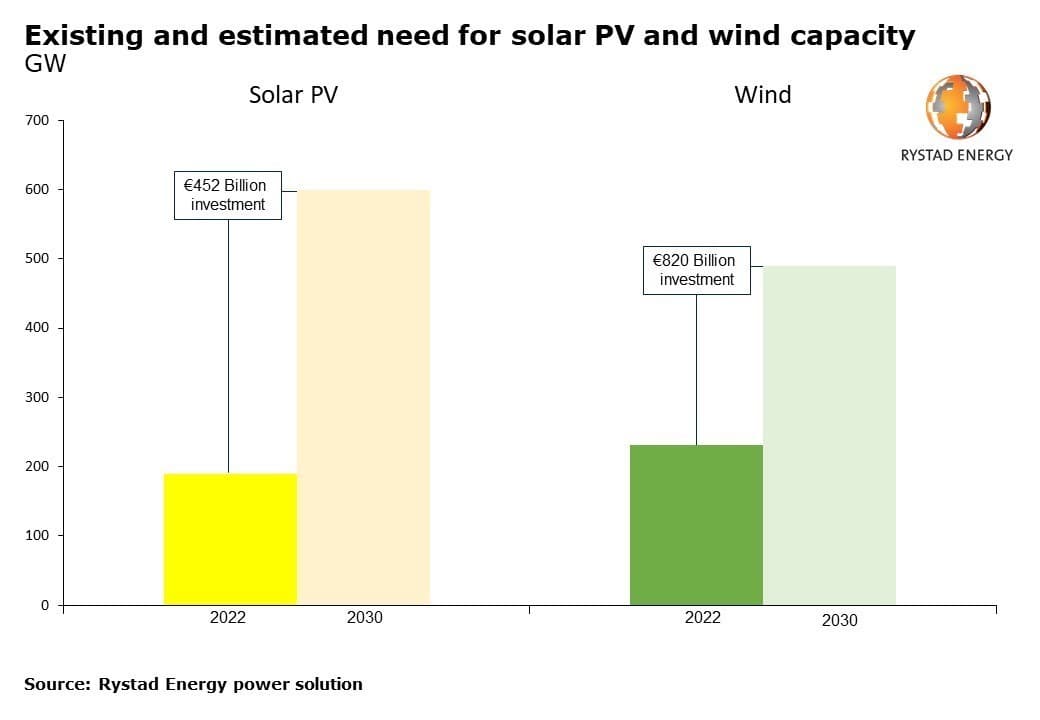The EU Needs More Than $1 Trillion for Plan to Ditch Russian Oil and Gas

All Global Research articles can be read in 51 languages by activating the “Translate Website” drop down menu on the top banner of our home page (Desktop version).
To receive Global Research’s Daily Newsletter (selected articles), click here.
Visit and follow us on Instagram, Twitter and Facebook. Feel free to repost and share widely Global Research articles.
***
The European Union’s REPowerEU seeks to reduce the European Union’s dependency on Russian fossil fuels and accelerate the transition away from carbon-intensive energy sources. The European Commission’s cost estimate, however, may fall short as Rystad Energy analysis suggests the plan will require at least €1 trillion in investment to meet the core objective of increasing renewable generation from 40% to 45% of total energy supply by 2030. Additional investment will be required to meet targets, including grid and battery storage developments to ensure a stable supply of energy as the whole European power system will need to be restructured. While the plan defines different angles to tackle the current crisis, the most detailed section outlines the roadmap for solar PV. The strategy aims to bring 320 gigawatts (GW) of solar PV online by 2025 and almost 600 GW by 2030, aiming to displace 9 billion cubic meters (Bcm) of gas demand. Europe currently has around 189 GW of installed solar PV capacity, meaning 131 GW need to be installed by the middle of the decade, or an equivalent of 44 GW per year. This would mean almost doubling the installation rate, which was 24 GW in 2021 and is expected to be 29 GW this year. To reach the targeted 600 GW by 2030, around 56 GW of new solar PV capacity would need to be installed during the following five years.
Assuming an average cost for solar PV of €1.1 million per megawatt (MW) of installed capacity, installing 411 GW between now and 2030 would represent an investment of €452 billion. Reaching 45% renewable energy supply by 2030 additionally requires significant investments in wind capacity – for which the plan does not have a lot of detail. Rystad Energy’s estimates suggest another 450-490 GW of wind capacity would need to be installed by 2030 to reach the target of 45% renewable energy supply, requiring an additional €820 billion in investments.
Such a transition will require huge investments but thus far the European Commission has been unclear about the total amounts allocated to achieve its goals. Recent announcements and communications mention that €225 billion is already available in loans and that an additional investment of €300 billion could be needed by 2030. Regardless of the total amount being assigned to new renewable energy developments, the figures seem to fall considerably below the required additional investment needed in power transmission, storage, gas infrastructure, and hydrogen production. Furthermore, such a large demand for new capacity will put additional pressure on the supply chain for solar panel and wind turbine manufacturing and could lead to a further increase in costs for these technologies.
“The ambition of the REPowerEU plan is huge. Power companies and energy markets will be looking for details on investments and infrastructure. While the targets are achievable, it will require wartime-like planning, levels of investment, construction, and production to meet goals by 2030,” says Carlos Torres Diaz, head of power research at Rystad Energy.
Targets breakdown
The EU has identified six key areas to reach REPowerEU targets:
- Smart investment
- Tackle slow and complex permitting for major renewable projects
- Saving energy
- Increase binding energy efficiency targets from 9% to 13%
- Cut gas and oil demand by 5% through behavioral changes
- Diversifying fossil fuels supplies
- Develop a joint purchasing mechanism to negotiate gas purchases
- Develop major hydrogen corridors in the Mediterranean and the North Sea
- Accelerating the rollout of renewable energy
- Increase the target for renewables from 40% to 45% of total energy supply by 2030
- Double solar PV capacity by 2025 and reach 600 GW of installed capacity by 2030
- Double the rate of heat pump deployment
- Eliminate red tape for renewable energy project permitting
- Produce 10 million tonnes of renewable hydrogen and import an additional 10 million tonnes by 2030
- Reducing fossil fuel consumption in industry and transport
- Reduce natural gas consumption from the industrial sector by an additional 35 Bcm by 2030 by using renewable hydrogen, biogas, and biomethane

Reducing red tape
REPowerEU acknowledged the need to address the bottlenecks in the permitting process. Currently, a wind energy permit could take up to nine years. To address this issue, the Commission put forward a new legislative proposal on renewables permitting based on three things:
- It will declare that renewables are presumed to be in “overriding public interest”. That would ensure renewable energy projects are prioritized, especially in the current scenario and until climate neutrality is reached.
- The proposal also urges nations to create so-called, “go-to” areas. These areas are to be set following an environment assessment (declaring that renewables projects are not a direct threat to the environment). Projects in these areas would need to be permitted within one year.
- The Commission also plans to keep existing permitting deadlines (i.e., two years) for the normal new projects and one year for repowered projects.
Speeding up the permitting process is crucial for the European Union to be able to meet its ambitious targets.
*
Note to readers: Please click the share buttons above or below. Follow us on Instagram, Twitter and Facebook. Feel free to repost and share widely Global Research articles.
Featured image is from ft.com

